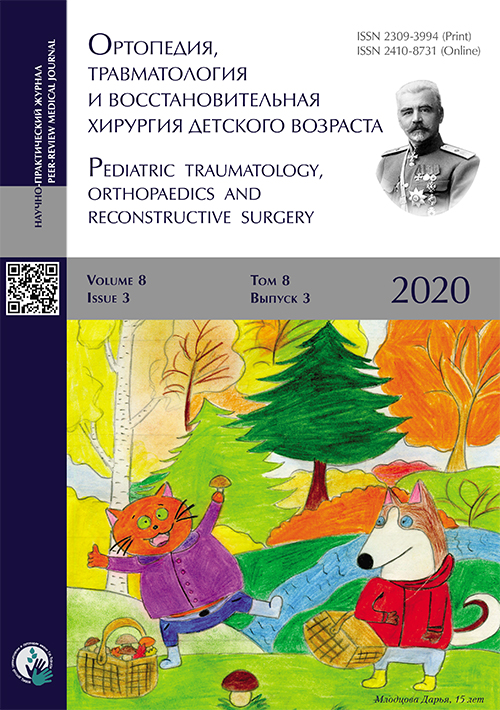脊柱X线片分析的自动化以客观评估特发性脊柱侧凸中脊柱侧凸变形的严重程度(初步报告)
- 作者: Lein G.A.1, Nechaeva N.S.1, Mammadova G.М.2, Smirnov A.A.2, Statsenko M.M.3
-
隶属关系:
- Scoliologic.ru Limited Liability Company
- INPRIS Limited Liability Company
- Mail.ru Limited Liability Company
- 期: 卷 8, 编号 3 (2020)
- 页面: 317-326
- 栏目: Experimental and theoretical research
- ##submission.dateSubmitted##: 22.05.2020
- ##submission.dateAccepted##: 03.08.2020
- ##submission.datePublished##: 06.10.2020
- URL: https://journals.eco-vector.com/turner/article/view/34150
- DOI: https://doi.org/10.17816/PTORS34150
- ID: 34150
如何引用文章
详细
论证:尽管国外对建立一种自动测量脊柱X线Cobb角的方法进行了广泛的研究,国内的一种辅助工具,
这使能够优化过程,确定脊柱侧弯畸形的严重程度,选择有效的治疗方法仍然不存在。
目的是研究在X线影像上选择脊柱和椎骨并构建椎间盘切线的算法,以便随后对特发性脊柱侧凸患者的脊柱X线影像进行自动分析,以评估其严重程度。
材料与方法。由有资格的放射科医师绘制,并包含在用于训练神经网络300张儿童和青少年特发性脊柱侧凸数字X光片的数据集中,以基于Cobb角的值确定脊柱侧凸的程度。使用了两种方法:确定滑动窗口方法和基于神经网络的算法,其证明后者的显著优势。
结果。建立了一个计算机系统的基础,用于自动分析医学X射线图像的脊柱。一种特殊的数据训练和增加方法,以及有资格的放射科医师绘制,使得训练神经网络和实现对85%以上的X线片的正确识别Cobb角成为可能。
结论。基于深度神经网络技术—脊柱识别和二维图像、Cobb角自动绘制,迈出了国内现代化创新产品的第一步。
全文:
作者简介
Grigory Lein
Scoliologic.ru Limited Liability Company
编辑信件的主要联系方式.
Email: Lein@scoliologic.ru
ORCID iD: 0000-0001-7904-8688
MD, traumatologist-orthopedist, PhD, General Director of Scoliologic.ru LLC
俄罗斯联邦, Saint PetersburgNatalia Nechaeva
Scoliologic.ru Limited Liability Company
Email: n.nechaeva@scoliologic.ru
ORCID iD: 0000-0003-3510-9164
MD, scientific worker, radiologist
俄罗斯联邦, Saint PetersburgGulnar Mammadova
INPRIS Limited Liability Company
Email: mgm.gulnar@gmail.com
ORCID iD: 0000-0001-9738-9259
analyst
俄罗斯联邦, MoscowAndrey Smirnov
INPRIS Limited Liability Company
Email: smirnov.andrey.aleksandrovich@gmail.com
ORCID iD: 0000-0002-7062-5677
Analyst
俄罗斯联邦, MoscowMaxim Statsenko
Mail.ru Limited Liability Company
Email: maxstatsenko@gmail.com
ORCID iD: 0000-0002-6826-9116
head of the development team
俄罗斯联邦, Moscow参考
- Ferguson AB. The study and treatment of scoliosis. South Med J. 1930;23(2):116-120.
- Сobb JR. Outline for the study of scoliosis. Instr Course Lect AAOS. 1948;5:261-275.
- Jentschura G. Zur pathogenese der säuglingsskoliose. Archiv für orthopädische und Unfall-Chirurgie, mit besonderer Berücksichtigung der Frakturenlehre und der orthopädisch-chirurgischen Technik. 1956;48(5):582-603.
- Абальмасова Е.А. Сколиоз в рентгеновском изображении и его измерение // Ортопедия и травматология. – 1964. – № 5. – С. 49–50. [Abalmasova EA. Skolioz v rentgenovskom izobrazhenii i ego izmerenie. Ortopediya i travmatologiya. 1964;(5):49-50. (In Russ.)]
- Тесаков Д.К., Тесакова Д.Д. Рентгенологические методики измерения дуг сколиотической деформации позвоночника во фронтальной плоскости и их сравнительный анализ // Проблемы здоровья и экологии. – 2007. – № 3. – С. 94–103. [Tesakov DK, Tesakova DD. Roetgenological methods of scoliotic spine deformity estimation in frontal plane and their comparative analysis. Problemy zdorov’ya i ekologii. 2007;(3):94-103. (In Russ.)]
- SOSORT. Методические рекомендации SOSORT 2011 г. Ортопедическое и реабилитационное лечение подросткового идиопатического сколиоза. 2011. [SOSORT. Metodicheskie rekomendatsii SOSORT 2011 g. Ortopedicheskoe i reabilitatsionnoe lechenie podrostkovogo idiopaticheskogo skolioza. 2011. (In Russ.)]
- Ньютон П.О., О’Браен М.Ф., Шаффлбаргер Г.Л., и др. Идиопатический сколиоз. Исследовательская группа Хармса: руководство по лечению. – М.: Лаборатория знаний, 2018. – 479 с. [Newton PO, O’Brien MF, Schafflebarger GL, et al. Idiopaticheskiy skolioz. Issledovatel’skaya gruppa Kharmsa: Rukovodstvo po lecheniyu. Moscow: Laboratoriya znaniy; 2018. 479 p. (In Russ.)]
- Wilson MS, Stockwell J, Leedy MG. Measurement of scoliosis by orthopedic surgeons and radiologists. Aviat Space Environ Med. 1983;54(1):69-71.
- Tanure MC, Pinheiro AP, Oliveira AS. Reliability assessment of Cobb angle measurements using manual and digital methods. Spine J. 2010;10(9):769-774. https://doi.org/10.1016/j.spinee.2010.02.020.
- Suwannarat P, Wattanapan P, Wiyanad A, et al. Reliability of novice physiotherapists for measuring Cobb angle using a digital method. Hong Kong Physiother J. 2017;37:34-38. https://doi.org/10.1016/ j.hkpj.2017.01.003.
- Wang J, Zhang J, Xu R, et al. Measurement of scoliosis Cobb angle by end vertebra tilt angle method. J Orthop Surg Res. 2018;13(1):223. https://doi.org/10.1186/s13018-018-0928-5.
- Horng MH, Kuok CP, Fu MJ, et al. Cobb angle measurement of spine from X-Ray images using convolutional neural network. Comput Math Methods Med. 2019;2019:6357171. https://doi.org/10.1155/ 2019/6357171.
- Pan Y, Chen Q, Chen T, et al. Evaluation of a computer-aided method for measuring the Cobb angle on chest X-rays. Eur Spine J. 2019;28(12):3035-3043. https://doi.org/10.1007/s00586-019-06115-w.
- Safari A, Parsaei H, Zamani A, Pourabbas B. A Semi-Automatic algorithm for estimating Cobb angle. J Biomed Phys Eng. 2019;9(3):317-326. https://doi.org/10.31661/jbpe.v9i3Jun.730.
- Qiao J, Liu Z, Xu L, et al. Reliability analysis of a smartphone-aided measurement method for the Cobb angle of scoliosis. J Spinal Disord Tech. 2012;25(4):E88-92. https://doi.org/10.1097/BSD.0b013e3182463964.
- Jones JK, Krow A, Hariharan S, Weekes L. Measuring angles on digitalized radiographic images using Microsoft PowerPoint. West Indian Med J. 2008;57(1):14-19.
- Rigo MD, Villagrasa M, Gallo D. A specific scoliosis classification correlating with brace treatment: Description and reliability. Scoliosis. 2010;5(1):1. https://doi.org/10.1186/1748-7161-5-1.
- He К, Gkioxari G, Dollár P, Girshick R. Mask R-CNN. 2017. arXiv: 1703.06870.
- Long J, Shelhamer E, Darrell T. Fully Convolutional Networks for Semantic Segmentation. 2014. arXiv: 1411.4038.
- He K, Zhang X, Ren S, Sun J. Deep Residual Learning for Image Recognition. 2015. arXiv: 1512.03385.
- Ronneberger O, Fischer P, Brox T. U-Net: Convolutional Networks for Biomedical Image Segmentation. 2015. arXiv: 1505.04597.
- Liu W, Rabinovich A, Berg AC. ParseNet: Looking Wider to See Better. 2015. arXiv: 1506.04579.
- Mukherjee J, Kundu R, Chakrabarti A. Variability of Cobb angle measurement from digital X-ray image based on different de-noising techniques. Int J Biomed Eng Technol. 2014;16(2):113. https://doi.org/10.1504/ijbet. 2014.065656.
- Okashi OA, Du H, Al-Assam H. Automatic spine curvature estimation from X-ray images of a mouse model. Comput Methods Programs Biomed. 2017;140:175-184. https://doi.org/10.1016/j.cmpb.2016.12.010.
- Pinheiro AP, Coelho JC, Veiga ACP, Vrtovec T. A computerized method for evaluating scoliotic deformities using elliptical pattern recognition in X-ray spine images. Comput Methods Programs Biomed. 2018;161:85-92. ttps://doi.org/10.1016/j.cmpb.2018.04.015.
补充文件







